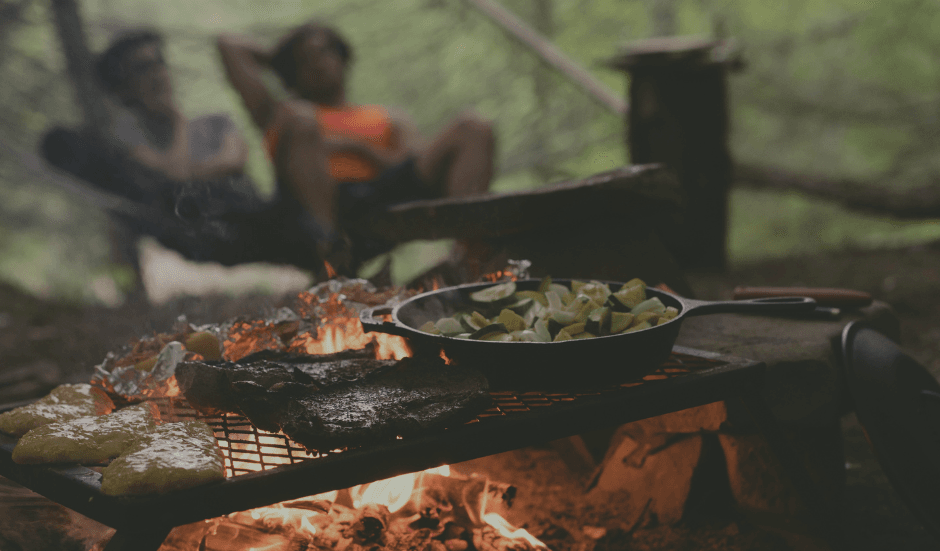Off-grid living is all about self-sufficiency and sustainability. This way of life, relying on alternative energy sources, brings a unique set of challenges and opportunities. One of the most essential aspects is cooking. Sustainable off-grid cooking isn’t just about making meals and providing sustenance; it’s about resourcefulness, eco-friendliness, creativity and passion.
Delve into the world of off-grid cooking. Whether you’re a seasoned off-grid enthusiast, a homesteader, or just curious about self-sufficiency, you’ll find valuable tips, recipes, and eco-conscious methods to prepare meals that align with the off-grid lifestyle.
Explore efficient off-grid cooking techniques, resource conservation, and the convenience of batch cooking. And for those days when cooking feels like a hassle, there are some suggestions for no-cook meals that are both nutritious and energy-efficient.
Discover the art of sustainable off-grid cooking, one practical and eco-friendly meal at a time.

Off-Grid Cooking Methods
Off-grid cooking encompasses a variety of methods, each offering unique benefits and suited to different environments and resources. From traditional techniques that have been used for centuries to modern innovations that maximise energy efficiency, the range of available off-grid cooking methods provide numerous ways to prepare delicious and sustainable meals.
Traditional Off-Grid Cooking
Open-Fire Cooking Methods: Cooking over an open fire is one of the oldest and most reliable methods for off-grid living. It requires minimal equipment – just a good fire pit, a grill grate, and some cast iron cookware. Open-fire cooking allows you to prepare meals using wood or other natural fuels found in your environment. The flavour imparted by cooking over an open flame is unmatched, adding a smoky depth to your dishes. There’s also something special and a bit primal about getting back to nature and cooking over a traditional fire.
Key tips for open-fire cooking:
- Use seasoned hardwoods like oak or hickory for a steady, long-lasting fire.
- Create a cooking zone by allowing the fire to burn down to hot coals, which provide consistent heat.
- Have basic fire safety knowledge and tools on hand to manage the flames effectively.
Using Wood-Burning Stoves: Wood-burning stoves offer a more controlled environment than open fires while still utilising natural fuels. These stoves can be highly efficient, providing both cooking and heating capabilities. They come in various sizes and designs, making them suitable for everything from tiny homes to larger off-grid setups. Gathering wood should be done responsibly, with a preference for using fallen branches or deadwood.
Benefits of wood-burning stoves:
- High efficiency: Modern wood stoves are designed to burn fuel more completely, reducing waste.
- Multi-functional: They can be used for cooking, heating water, and warming your living space.
- Renewable resource: Wood is a sustainable fuel source when sourced responsibly.
Modern Off-Grid Cooking
Modern technology has introduced a range of energy-efficient appliances designed specifically for off-grid living. These appliances use minimal power, making them ideal for homes relying on renewable energy.
Popular energy-efficient cooking appliances include:
- Solar Ovens: These devices use reflective surfaces to focus sunlight onto a cooking chamber, making them excellent for environmentally friendly cooking. They eliminate fuel costs and reduce emissions. They are perfect for sunny days and can reach temperatures high enough to bake and roast.
- Propane-Powered Stoves: Propane is a convenient and portable fuel source. More traditional propane stoves are efficient and can be used for various cooking tasks, from boiling water to frying. Ensure you are purchasing propane in a way that minimises waste and works best for your setup.
- Electric/Induction Cookers: When paired with a robust solar power system and battery storage, electric and induction cookers provide precise temperature control and fast cooking times. Induction cookers are incredibly efficient as they directly heat the cookware through magnetic induction.
- Diesel cookers: Although less common, these provide a reliable option for off-grid cooking. They are highly efficient and particularly useful in colder climates where other fuel sources may be harder to come by.
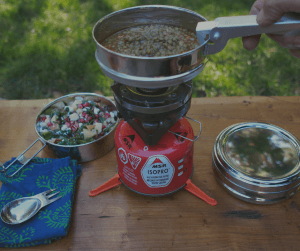
Incorporating these traditional and modern methods into your off-grid kitchen setup can help you cook sustainably and efficiently, no matter your living situation. By understanding and utilising these various techniques, you can enjoy a versatile and eco-friendly approach to off-grid cooking.
Sustainable Off-Grid Kitchen Setup
Creating a sustainable off-grid kitchen involves making thoughtful choices about cookware and kitchen design. These considerations ensure that your cooking practices are not only efficient and practical but also environmentally friendly.
Efficient Cookware Choices
Choosing the right cookware is crucial for efficient off-grid cooking. Durable materials like cast iron and stainless steel are excellent choices due to their longevity and heat retention properties.
- Cast Iron: Known for its durability and excellent heat retention, cast iron cookware can be used on open fires, wood-burning stoves, and even modern cooktops. With proper care, cast iron can last for generations.
- Stainless Steel: Lightweight and resistant to rust and corrosion, stainless steel cookware is versatile and easy to clean. It’s suitable for various cooking methods and is particularly useful for its non-reactive nature, ensuring your food retains its intended flavours.
- Other Sustainable Options: Look for cookware made from recycled materials or with eco-friendly coatings that reduce the need for excessive oil and make cleaning easier.
Proper maintenance of your cookware extends its life and ensures optimal performance. For cast iron, regular seasoning (applying a thin layer of oil and heating) prevents rust and maintains its non-stick surface. Stainless steel should be cleaned thoroughly to prevent staining and maintain its sheen. Avoid harsh chemicals and opt for natural cleaning agents like vinegar and baking soda to keep your cookware in top condition.
Off-Grid Kitchen Design
An off-grid kitchen should be designed with functionality and sustainability in mind. This involves maximising natural light, ensuring proper ventilation, and strategically organising your space.
- Maximising Natural Light and Ventilation: Position your kitchen to take advantage of natural sunlight, reducing the need for artificial lighting during the day. Large windows or skylights can help achieve this. Ventilation is equally important to disperse cooking odours and smoke. Incorporate vents or exhaust fans to maintain air quality.
- Storing Food in Cooler Areas: Utilise natural cool areas, like basements or shaded outdoor spaces, for food storage. This reduces the need for refrigeration and helps preserve perishable items.
- Shielding Gas Burners from Wind: Ensure your gas burners are protected from wind or strong drafts to maintain efficiency. Windshields or strategic placement of your cooking setup can help prevent heat loss and improve fuel efficiency.
- Efficient Workspace: An off-grid kitchen should maximise workspace efficiency. Consider counters and storage options that optimise available space while keeping essential cooking tools within arm’s reach.
By integrating these sustainable practices into your off-grid kitchen, you can create a space that is not only practical and efficient but also aligned with eco-friendly principles.
Energy-Saving Kitchen Gadgets
Utilising energy-saving gadgets and appliances in your off-grid kitchen is essential for maintaining efficiency and sustainability. These tools can help you cook more effectively while conserving valuable resources.
Kitchen items that Can Help Save Energy when Cooking Off-Grid
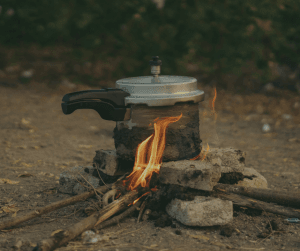
In an off-grid kitchen, every watt and drop of fuel counts. Here are some energy-saving gadgets that can make a significant difference:
- Thermal Cookers: These cookers, also known as hayboxes or wonderbags, use retained heat to finish cooking food without the need for additional energy. After bringing food to a boil, you transfer the pot into an insulated container that continues the cooking process using stored heat. This method is perfect for slow-cooked meals and soups, saving both energy and time.
- Pressure Cookers: A pressure cooker significantly reduces cooking time by raising the pressure inside the pot, which increases the boiling point of water. This means meals can be prepared more quickly and with less fuel, making it an ideal choice for an off-grid kitchen.
- Dutch Ovens: Cast iron Dutch ovens are sturdy and versatile off-grid cooking tools. They serve as kitchen workhorses and can be used over an open fire, on a conventional stove, or even buried for slow-cooking. Dutch ovens are known for their durability and excellent heat-retaining properties.
- Eco Kettles: Designed to boil only the amount of water you need, eco kettles minimise energy waste. They often come with adjustable settings to heat water to different temperatures, perfect for making tea or coffee without using excess energy. Stove-top, or whistling kettles are also extremely popular and are much more efficient than a typical electric kettle.
- Energy-Efficient Refrigerators: Refrigeration is a necessary component of any kitchen. Look for models designed specifically for off-grid use, which often feature thicker insulation and more efficient compressors which run on minimal power, making them suitable for solar or wind-powered homes.
By incorporating these energy-saving gadgets and appliances, you can significantly reduce your environmental impact and enhance the efficiency of your off-grid kitchen. These tools not only make off-grid living more convenient but also align with the principles of sustainability and resource conservation.
Sustainable Recipe Ideas
Crafting meals that align with sustainable off-grid living involves using fresh, locally sourced ingredients and efficient cooking methods. Here are some ideas to inspire your off-grid culinary adventures:
Farm-to-Table Meals
Growing your own food is a cornerstone of off-grid self-sufficiency. Depending on your off-grid set-up you can utilise ingredients grown on your own property. Use freshly grown vegetables, fruits, and herbs, to create delicious and sustainable meals. Eating seasonally also supports sustainable farming practices and reduces reliance on imported goods. You can enjoy produce at its peak, which is often more nutritious and flavourful.
- Vegetable Stir-Fry: Fry up a mix of garden vegetables like bell peppers, spinach or kale, and snap peas with garlic and ginger. Add some sauce and serve over rice or noodles.
- Fruit Salad: Gather up an array of fresh fruit from the garden like strawberries, peaches, and blueberries then add syrup or local honey for a delicious dessert.
- Summer Veggie Pasta: In summer, incorporate tomatoes, courgette, and basil into a light pasta dish. Drizzle with olive oil and sprinkle with parmesan.
- Winter Root Vegetable Stew: In winter, use root vegetables like carrots, potatoes, and turnips. Cook them slowly in a broth with herbs and spices for a hearty, warming meal.
One-Pot Meals
One-pot meals simplify cooking and cleanup, making them perfect for off-grid living. They also allow for efficient use of heat and resources.
- Hearty Chili: Combine beans, tomatoes, onions, and spices in a pot. Let it simmer for a few hours, developing deep flavours. Add ground meat or keep it vegetarian with additional beans and veggies.
- Chicken and Rice: Cook chicken pieces with rice, broth, and your choice of vegetables. Season with herbs and spices for a comforting, all-in-one meal.
- Lentil Soup: Lentils cook quickly and are packed with protein and fiber. Add vegetables like carrots, celery, and spinach, and season with cumin and coriander.
- Curry: A pot of curry can be made with coconut milk, a variety of vegetables, and your choice of protein. Serve with rice or flatbread.
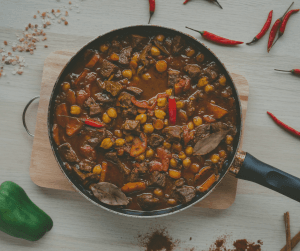
No-Cook and Low-Cook Meals
In hot weather or when conserving fuel, no-cook or low-cook meals are ideal. They are quick to prepare and often require minimal energy.
- Gazpacho: This chilled Spanish soup is made from blended tomatoes, cucumbers, peppers, and onions. It’s refreshing and packed with vitamins.
- Garden Fresh Salad: Combine freshly harvested greens, tomatoes, cucumbers, and herbs for a vibrant, nutritious salad. Dress with a homemade vinaigrette using olive oil, lemon juice, and herbs.
- Overnight Oats: Mix oats with milk or yogurt and let them soak overnight. Add fruits, nuts, and honey in the morning for a quick, nutritious breakfast.
- Cold Couscous Salad: boil some water and add to couscous in advance then mix with fresh vegetables, olives, and a light vinaigrette for a filling and energy-efficient meal.
Batch Cooking
Batch cooking involves preparing large quantities of food at once, then storing portions for later use. This method saves time and energy, making it ideal for off-grid living.
- Bean and Vegetable Soup: Make a large pot of soup and freeze portions in reusable containers. Reheat as needed for quick and easy meals.
- Baked Casseroles: Prepare a large casserole dish with layers of vegetables, pasta, and cheese. Bake and divide into portions for several meals.
Here are some tips for batch cooking in off-grid settings:
- Use a Thermal Cooker: Cook large quantities of food and keep them hot for hours without additional energy.
- Efficient Oven Usage: If using a regular oven for cooking, ensure you utilise the space wisely. If you are cooking a casserole consider making bread or other baked goods at the same time.
- Plan Around Seasonal Ingredients: Batch cook when seasonal produce is abundant, preserving the surplus by canning, drying, or freezing.
By incorporating these sustainable recipe ideas into your off-grid kitchen, you can enjoy delicious meals while maintaining an eco-friendly and resource-efficient lifestyle.
Off-Grid Cooking Challenges
Living off-grid presents unique challenges, particularly when it comes to cooking. Adapting to these challenges requires thoughtful strategies for conserving energy and water, as well as effective food preservation methods to ensure self-sufficiency throughout the year.
Energy Conservation
Conserving energy and fuel is essential for off-grid cooking, especially when relying on limited resources. Efficient cooking practices can help you make the most of your resources.
- Use Lids: Cover pots and pans with lids to retain heat, which speeds up cooking times and conserves energy.
- Utilise Residual Heat: Turn off the stove or oven a few minutes before the food is done and let residual heat finish the cooking process.
- Insulate Cookware: Using insulated or thermal cookware retains heat and reduces the amount of fuel needed for cooking.
- Cook in Batches: Preparing multiple meals at once reduces the frequency of cooking, saving fuel and energy.
- Pre-Soak Ingredients: Soaking beans, grains, and other ingredients before cooking can significantly reduce cooking times and fuel consumption.
- Seasonal Adjustments: Adapt your cooking methods to the seasons. In summer, avoid heat-intensive cooking to prevent overheating your living space. In winter, take advantage of wood-burning stoves to cook and heat your home simultaneously.
Preserving Food for Off-Grid Living During Different Seasons
Food preservation is a key aspect of off-grid living, allowing you to enjoy seasonal produce year-round. Various methods can help extend the shelf life of your harvests and reduce food waste.
- Canning: Preserve fruits, vegetables, and even meats by canning them in jars. This method ensures a long shelf life and is ideal for storing food without refrigeration.
- Drying: Dehydrate fruits, vegetables, and herbs using solar dehydrators or low-heat ovens. Dried foods take up less space and can be easily rehydrated for use in recipes.
- Fermenting: Fermentation is a natural preservation method that enhances the nutritional value of foods. Fermented vegetables, like sauerkraut and kimchi, can last for months without refrigeration.
- Freezing: If you have access to a freezer powered by renewable energy, freezing is an excellent way to preserve the taste and nutritional value of many foods.
- Root Cellaring: Store root vegetables, apples, and other durable produce in a cool, dark place like a root cellar. This method can keep food fresh for several months.
- Solar Dehydrators: Harness the power of the sun to preserve food. Solar dehydrators can efficiently dry fruits, vegetables, and herbs, extending their shelf life.
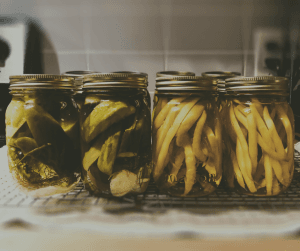
Water Efficiency
Water is a precious resource in off-grid living, and efficient use in cooking is essential. Implementing water-saving techniques can help you manage your supply effectively.
- Reuse Cooking Water: Use the water from boiling vegetables or pasta for soups and stews. This not only conserves water but also retains nutrients.
- Minimal Water Cooking: Opt for steaming or pressure cooking, which require less water than traditional boiling methods.
- One-Pot Meals: Prepare meals that require minimal water by combining ingredients in a single pot. This reduces both water use and cleanup time.
- Collect Rainwater: Set up a rainwater harvesting system to collect and store water for cooking and other household uses.
- Cleaning Efficiency: Use a small amount of water for washing dishes. Soak dishes briefly to loosen food particles, then rinse using minimal water.
By addressing these challenges with practical solutions, you can maintain a sustainable and efficient off-grid kitchen. These strategies help conserve valuable resources, ensuring that your off-grid lifestyle remains both manageable and eco-friendly.
Sustainable Food Practices for Cooking Off-Grid
A sustainable off-grid kitchen not only minimises environmental impact but also fosters community and resourcefulness. Explore practical strategies to enhance sustainability in your off-grid cooking practices.
Reducing Food Waste
Reducing food waste is crucial for sustainability and self-sufficiency. Effective planning and creative uses for leftovers can help you make the most of your food supply.
- Meal Planning: Plan your meals in advance to use up ingredients before they spoil. This reduces waste and ensures you always have what you need.
- Proper Storage: Use airtight containers and cool, dark storage spaces to extend the shelf life of your food.
- Composting: Compost food scraps to enrich your garden soil. This practice recycles nutrients back into your growing space, supporting a sustainable food cycle. If you keep chickens or pigs, you may also be able to give them food scraps to diversify their diet.
- Broths and Stocks: Use vegetable peels, herb stems, and bones to make nutrient-rich broths and stocks.
- Leftover Transformations: Turn yesterday’s dinner into today’s lunch by repurposing leftovers into new dishes.
- Zero-Waste Recipes: Explore recipes that utilise whole foods, including stems, leaves, and peels, to minimise waste.
Community and Sharing
Community collaboration can enhance the sustainability and enjoyment of off-grid cooking. Sharing resources and knowledge strengthens bonds and maximises efficiency.
- Shared Resources: Pooling resources like communal gardens, shared kitchens, or bulk purchasing can reduce individual costs and effort.
- Community Meals: Organise potlucks or communal meals where everyone contributes a dish. This fosters a sense of community and allows for diverse, shared experiences.
- Skill Sharing: Exchange cooking techniques, preservation methods, and recipes with others. Learning from your community can introduce you to new and efficient ways of cooking. Join online communities focused on off-grid living to share tips, recipes, and advice with a broader network.
- Workshops and Classes: Host or attend workshops on sustainable cooking practices, gardening, and food preservation.
- Bartering and Trading: Trade excess produce or homemade goods with neighbours to diversify your food options without additional cost.
Wild Foraging and Local Sourcing
Wild foraging can supplement your diet with nutritious and free ingredients found in nature. Learning to identify and harvest edible plants safely adds variety to your meals and enhances your connection with the environment. Never eat anything you are unsure about and consider if any foraged items could have been chemically sprayed or contaminated in anyway. You can also grow your own food and buy locally sourced produce.
- Foraging for Edible Plants: Familiarise yourself with local edible plants, berries, nuts, and mushrooms. Plan foraging activities according to the seasonal availability of wild foods.
- Supporting Local Farmers: Buy directly from local farmers and markets to support the local economy and reduce the carbon footprint of transported goods.
- Growing Your Own Food: Maintain a garden to grow your own fruits, vegetables, and herbs. This ensures a steady supply of fresh produce and reduces reliance on external sources.
By integrating these sustainable practices into your off-grid cooking routine, you can reduce waste, foster community connections, and embrace the full potential of your natural surroundings. This holistic approach ensures that your off-grid lifestyle remains efficient, eco-friendly, and enriching.
Conclusion
Sustainable off-grid cooking is more than just a way to prepare meals; it’s a lifestyle that embodies resourcefulness, environmental stewardship, and community spirit. There is a diverse range of off-grid cooking methods, from traditional open-fire techniques to modern energy-efficient appliances, all tailored to enhance your self-sufficient lifestyle. By incorporating durable, sustainable cookware and designing functional, eco-friendly kitchens, you can maximise efficiency and minimise your ecological footprint.
Living off-grid it is important to make use of energy-saving gadgets, and embrace farm-to-table meals, one-pot recipes, and batch cooking to optimise ingredients and reduce waste. There are going to be challenges when off-grid cooking, such as energy conservation, seasonal food preservation, and water efficiency, but there are practical solutions to navigate these hurdles. There is value in community and sharing resources, where collaboration can enhance sustainability and enrich the off-grid lifestyle.
Living off-grid offers a unique opportunity to connect deeply with your environment and community while making a positive impact on the planet. By adopting sustainable cooking practices, you contribute to a healthier ecosystem and foster self-sufficiency. Embrace this journey of eco-friendly off-grid cooking, continually seeking ways to improve and share your knowledge, and enjoy the profound satisfaction that comes from living in harmony with nature.
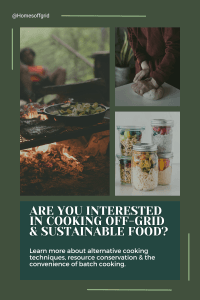
To find out more about living off-grid return to the Reading Room.


